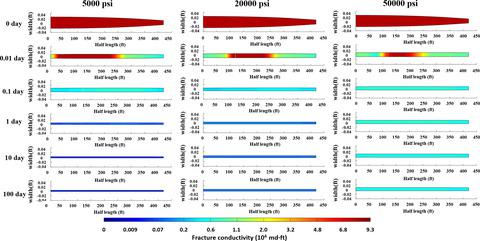当前位置:
X-MOL 学术
›
Energy Sci. Eng.
›
论文详情
Our official English website, www.x-mol.net, welcomes your feedback! (Note: you will need to create a separate account there.)
A semi‐analytical model for capturing dynamic behavior of hydraulic fractures during flowback period in tight oil reservoir
Energy Science & Engineering ( IF 3.8 ) Pub Date : 2020-07-15 , DOI: 10.1002/ese3.769 Pin Jia 1, 2 , Ming Ma 1, 2 , Linsong Cheng 1, 2 , Christopher R. Clarkson 3
Energy Science & Engineering ( IF 3.8 ) Pub Date : 2020-07-15 , DOI: 10.1002/ese3.769 Pin Jia 1, 2 , Ming Ma 1, 2 , Linsong Cheng 1, 2 , Christopher R. Clarkson 3
Affiliation

|
Hydraulic fracturing has been successfully employed for unconventional oil and gas recovery for decades. During flowback, the closure of the fracture may exhibit with the pressure drop of fracturing fluid dewatering. However, fracture closure always is ignored or treated as stress‐dependent fracture properties in previous flowback models. This paper presented a dynamic fracture model, which can comprehensively capture the dynamic behavior of hydraulic fractures during the flowback. A nonlinear relationship between fracture aperture and contact stress acting on the fracture surfaces is adopted to simulate fracture closure. The fracture aperture calculated by the displacement discontinuity method (DDM) is used to characterize the fracture pore volume and fracture conductivity, which will be dynamically updated in the flow model. Then, the pressure and saturation of each phase, along with the displacement on the fracture surface, are calculated by solving flow equations and geomechanics equations with iterative coupling approach. The new semi‐analytical model is validated by comparing it with a fully coupled stress‐porosity pressure numerical simulation model setup by ABAQUS® and CMG. Then, the dynamic behaviors of hydraulic fractures are investigated in detail by several cases. Results show that fracture closure is an important reason for the decline in production during the flowback and early production. And it is more important to enhance the properties of the stimulated reservoir volume (SRV) than to only create a fracture with high conductivity. Lastly, the key parameters (the fracture effective length and fracture conductivity under variable contact stress) can be interpreted by history‐matching the field flowback data.
中文翻译:

致密油藏返排期水力压裂动态行为的半解析模型
水力压裂已成功用于非常规油气采收数十年。在回流期间,裂缝的闭合可能随着压裂液脱水的压降而显现。但是,在以前的回流模型中,裂缝闭合总是被忽略或视为与应力有关的裂缝特性。本文提出了一种动态裂缝模型,该模型可以全面地记录回流过程中水力裂缝的动力学行为。采用裂缝孔径与作用在裂缝表面的接触应力之间的非线性关系来模拟裂缝闭合。通过位移不连续性方法(DDM)计算的裂缝孔径用于表征裂缝的孔隙体积和裂缝的电导率,这将在流动模型中动态更新。然后,通过迭代耦合方法求解流动方程和地质力学方程,计算出各相的压力和饱和度以及裂缝表面的位移。通过与ABAQUS建立的完全耦合的应力-孔隙度压力数值模拟模型进行比较来验证新的半分析模型®和CMG。然后,通过几种情况详细研究了水力压裂的动力学行为。结果表明,裂缝闭合是返排和早期生产期间产量下降的重要原因。与仅产生具有高电导率的裂缝相比,增强受激储层体积(SRV)的属性更为重要。最后,关键参数(在可变接触应力下的裂缝有效长度和裂缝电导率)可以通过对历史现场回流数据进行匹配来解释。
更新日期:2020-07-15
中文翻译:

致密油藏返排期水力压裂动态行为的半解析模型
水力压裂已成功用于非常规油气采收数十年。在回流期间,裂缝的闭合可能随着压裂液脱水的压降而显现。但是,在以前的回流模型中,裂缝闭合总是被忽略或视为与应力有关的裂缝特性。本文提出了一种动态裂缝模型,该模型可以全面地记录回流过程中水力裂缝的动力学行为。采用裂缝孔径与作用在裂缝表面的接触应力之间的非线性关系来模拟裂缝闭合。通过位移不连续性方法(DDM)计算的裂缝孔径用于表征裂缝的孔隙体积和裂缝的电导率,这将在流动模型中动态更新。然后,通过迭代耦合方法求解流动方程和地质力学方程,计算出各相的压力和饱和度以及裂缝表面的位移。通过与ABAQUS建立的完全耦合的应力-孔隙度压力数值模拟模型进行比较来验证新的半分析模型®和CMG。然后,通过几种情况详细研究了水力压裂的动力学行为。结果表明,裂缝闭合是返排和早期生产期间产量下降的重要原因。与仅产生具有高电导率的裂缝相比,增强受激储层体积(SRV)的属性更为重要。最后,关键参数(在可变接触应力下的裂缝有效长度和裂缝电导率)可以通过对历史现场回流数据进行匹配来解释。


























 京公网安备 11010802027423号
京公网安备 11010802027423号